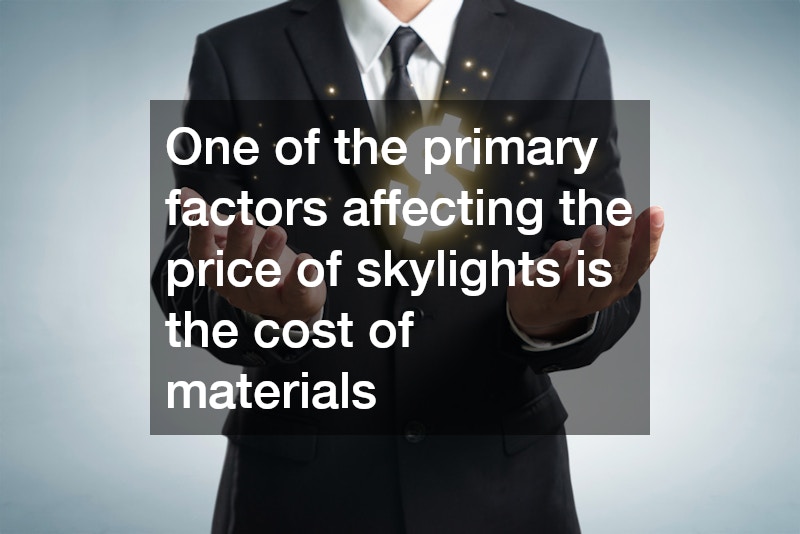Skylights can bring natural light into your home, providing aesthetic and energy-saving benefits. However, understanding the pricing structure for skylights can be complex. In this article, we’ll break down the various factors that affect the cost of skylights.
Material Costs
One of the primary factors affecting the price of skylights is the cost of materials. Skylights are typically made from glass or acrylic, each with its unique benefits and price points. Glass skylights tend to be more expensive due to their durability and insulation properties.
Acrylic skylights, while more affordable, may scratch easier and offer less insulation. Another material consideration is the type of glazing used, such as single, double, or triple glazing. Each layer of glazing can increase energy efficiency, but also contributes to the overall cost.
Additionally, some skylight frames are made from materials like wood, metal, or vinyl. The choice of frame material can affect both the cost and the aesthetic appeal of the skylight. For instance, wooden frames may offer a classic look but can be pricier than vinyl.
Size and Shape
The dimensions and design of the skylight are crucial factors in determining pricing. Larger skylights that allow more light into a space will naturally cost more due to increased material usage. Skylight shape can also impact the price; complex designs like domes or pyramids might be more expensive than traditional flat shapes.
Additionally, custom-shaped skylights can require specialized manufacturing processes. Custom designs usually require more labor and specialized materials, which can drive up the cost. However, unique shapes can provide distinctive aesthetic appeal that justifies the extra expenditure.
In many cases, the available space and architectural style will dictate the appropriate size and shape of a skylight. It’s essential to consult with professionals to choose a skylight that suits both your home’s design and budget. Proper installation and fitting are imperative for efficiency and the prevention of leaks.
Installation Complexity
The complexity of the installation is another significant factor in pricing skylights. Roof pitch, roofing material, and accessibility can all influence the complexity and cost of installation. For instance, installing a skylight on a relatively flat roof might be less expensive than on a steeply pitched roof.
The roofing material, such as metal or tile, could also add to the complexity. Some materials require specialized installation methods to ensure the skylight is securely and properly fitted. An easily accessible roof lowers installation costs, whereas difficult-to-access areas might increase labor costs.
Moreover, additional installation features such as ventilation options or motorized opening mechanisms can add to the cost. These features require extra time and expertise to install, increasing both labor and material costs. Choosing a reputable installer is crucial for ensuring a seamless and lasting installation.
Energy Efficiency and Features
Energy efficiency is a key consideration in the cost of skylights. Modern skylights often come with features like low-emissivity (low-E) coatings, which help to reduce heat transfer. These coatings can maintain a more consistent indoor temperature, offering energy savings but also increasing the upfront cost.
Energy-efficient designs, such as those incorporating multiple layers of glazing or specialized tints, often have a higher price point. These features enhance performance by reducing the need for artificial lighting and controlling heat gain and loss. Consumers can benefit in the long term despite potential higher initial costs.
Additional features, such as built-in blinds or automated opening systems, offer convenience and control over light and airflow. While they contribute to the overall price, these features can add significant value and comfort to a home. Such innovations align with modern needs for sustainability and smart home integration.
Brand and Warranty
The brand and warranty of skylights also play a crucial role in pricing. Well-established brands may charge a premium for their products but often provide assurance regarding quality and durability. Investing in a reputable brand can lead to fewer issues and headaches in the long run.
A comprehensive warranty is another factor to consider when evaluating skylight costs. Warranties vary between manufacturers in length and coverage, affecting consumer confidence and pricing. A robust warranty provides peace of mind, ensuring protection against manufacturer defects and installation issues.
The peace of mind that comes with a reliable warranty and a quality brand often justifies the higher initial cost. Consumers should carefully compare brands and warranty offerings when selecting skylights for their home. This diligence can save money and trouble in the future and is a crucial part of making an informed decision.
.








